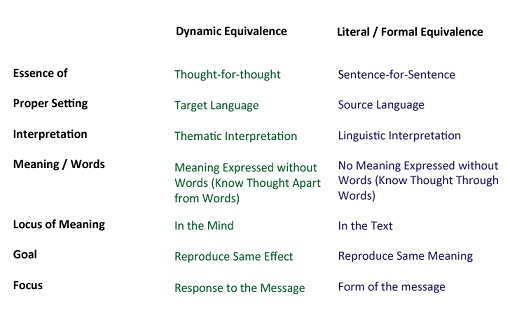COMPELLING TRUTH
Bible Translations
Part 2: Comparison between Paraphrase, Dynamic Equivalence and Literal / Formal
By Robin Schumacher

The recent decision by Houston's First Baptist church to formally discontinue the use of the New International Version (NIV) Bible resurfaced the sometimes very touchy subject of Bible translations. Despite the fact that many Christians have never given thought as to how the Bible they were given/bought/use was produced for their native language, emotions can surprisingly and quickly run very hot when someone questions the veracity of a particular Bible translation.
In part 1 of this post, I covered the basic core approaches to Bible translation and left things dangling with the question of which Bible translation is ‘best' out of the three translation philosophies – paraphrase, dynamic equivalence, and literal/formal equivalence.
So which is it?
I've yet to meet any scholar, theologian, pastor, apologist, etc., who believes that a paraphrase is the best translation to use for Bible reading or study. A paraphrase may be interesting to use from time to time to see how a particular translator might summarize or reword the sacred text for everyday speech, but outside of a textual comparison with more studious translations, the paraphrase should be discarded – at least where methodological Bible study is concerned.
Removing the paraphrase from the mix leaves us with the dynamic vs. formal equivalence approaches. To get an at-a-glance understanding of the key differences between the two methods, Dr. Thomas Howe, in a critique of the dynamic equivalence approach written in an edition of the Christian Apologetics Journal (Vol. 5, No 1, Spring 2006), reproduced the following chart from Dr. Norman Geisler that summarizes the differences between the two:

Again, the goal of the dynamic equivalence is to produce the same effect in the reader today as the original text did back in its day. The objective of the literal formal is to reproduce the same meaning for the reader today as the original text did back in the first century.
This can seem difficult to grasp at first, so perhaps the best way to see the differences is with a quick example.
The Beginning of the Sermon on the Mount
In Matthew 5, we have the opening lines that kick off Jesus' most famous discourse, the Sermon on the Mount. Let's compare the translation differences between a dynamic equivalence and literal/formal translation:
"Now when he saw the crowds, he went up on a mountainside and sat down. His disciples came to him, and he began to teach them, saying” (Matthew 5:1–2, NIV – Dynamic Equivalence).
“When Jesus saw the crowds, He went up on the mountain; and after He sat down, His disciples came to Him. He opened His mouth and began to teach them, saying” (Matthew 5:1–2, NASB – Literal/Formal).
Notice that the key difference between the two translations is found in the phrase “He opened His mouth”, which appears in the literal/formal translation, but not the dynamic equivalence text. The NIV leaves out this phrase because its goal is to produce what the translators believe is the same effect these two verses would have had on their audience back then: Jesus is about to teach a crowd of people on a mountain and how else does someone teach in such a situation other than to open their mouth? Therefore, the dynamic equivalence translators omit this phrase that is found in copies of the original text.
But is there more to the phrase “He opened His mouth” than the NIV translators believe? Many theologians believe there is.
Matthew only uses this phrase one other time in his gospel: to describe the finding of the shekel in the fish's mouth that Peter is told by Christ to give for payment of temple taxes (cf. Matt 17:27). So why does Matthew use the phrase to begin Chapter 5?
The preceding chapter four describes Jesus' temptation encounter with Satan in the wilderness. The first temptation of the loaves ends with Christ's countering Satan's offer by quoting a passage from Deuteronomy that has Moses giving God's directives at Sinai: “He humbled you and let you be hungry, and fed you with manna which you did not know, nor did your fathers know, that He might make you understand that man does not live by bread alone, but man lives by everything that proceeds out of the mouth of the LORD” (Deuteronomy 8:3, emphasis added).
Some scholars believe that the Sermon on the Mount is a parallel to the Old Testament giving of the law for Israel and the Theocratic kingdom at that time. In the same way that God gave His laws for that time, Matthew is depicting Jesus giving His laws for the Messianic kingdom in chapters 5-7. As God spoke creation into being and sent his law through that which proceeded out of His mouth, Jesus is giving His law by opening His mouth. Matthew is in effect saying we had all better listen because God is opening His mouth and speaking again.
While it is understandable that some may believe too much is being read into the text from this association, it should also be remembered that the Bible is a spiritually inspired work that is richer beyond our capabilities so such linkages in Scripture can certainly not be ruled out. Moreover, even if such a position is not valid, to remove the Matthew phrase from the painstakingly copied texts that we have from the originals seems imprudent at best.
This is just one example of others that can be brought to the witness stand in favor of using a translation that adheres to the literal/formal methodology. Further, when one remembers examples from Scripture such as Paul using the difference between a singular and a plural noun to make a fairly significant theological statement (cf. Gal. 3:16), in my opinion, I believe it wise to use a translation that does everything in its power to preserve the literal words found in the inspired text. To me, this equates to using a literal/formal translation.
Next Steps – Which Literal/Formal?
The natural next question is, which literal/formal translation should I use? There are a number of such translations available and they are certainly not all the same.
Let me be up front and say I have no intention of touching on the “King James only” debate or set of arguments that accompany that crowd in this brief article. If you love and value the KJV or NKJV, then by all means, enjoy. For myself, after some exploratory research and chronicling what translations the expository teaching pastors who I listen to on a regular basis use, I've come to restrict myself to the NASB and ESV, in that order.
Few scholars disagree that the NASB is above other literal formal translations where the key litmus test is how closely the translation adheres to the words in the inspired text. Any knock it receives is usually in the area of readability, although I personally have never had a problem with how the NASB structures its sentences.
Without a doubt, the ESV has the most recent momentum in recent years, with heavy hitters such as Dr. John Piper (among many others) championing the translation. I greatly enjoy reading from the ESV, however when push comes to shove, I prefer the NASB for some small, but meaningful reasons.
First, I like that the NASB (like the KJV) has the words that the translators have inserted for readability in italics so it's easy to know what words are from the inspired text and what words have come from the translation committee. The ESV does not do this.
I also like the fact that the NASB capitalizes pronouns (e.g. Him, He) when they are used for God or Jesus. The respect that such capitalization shows for the person of God sits well with me.
Finally, while the ESV is certainly an excellent translation, even its proponents admit it falls below the NASB in a word-for-word/sentence-for-sentence translation. So, for these reasons, in my own personal Bible study, I rely on the NASB.
Next: Part 3: What is the Best Study Bible?
Bible Translations The Series
Part 1: The Issues
Part 2: A Comparison of Translation Methods
Part 3: What is the Best Study Bible?
Image Credit: Wil C. Fri; "The Great Giveaway, Cont. (Bibles)"; Creative Commons
comments powered by Disqus
Republished 5-20-13

